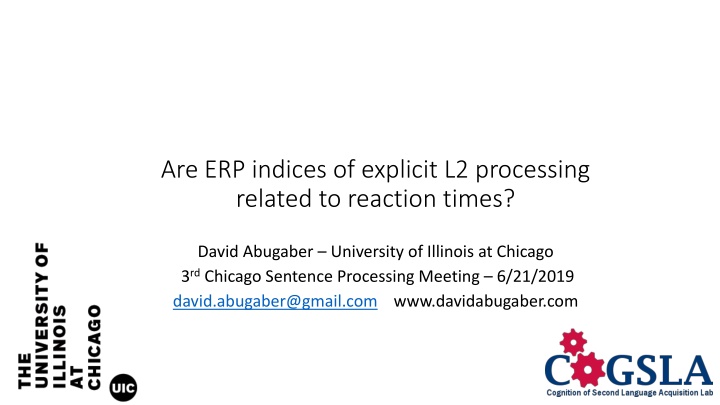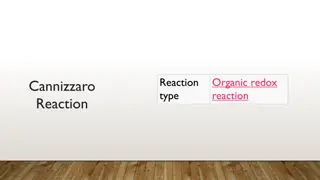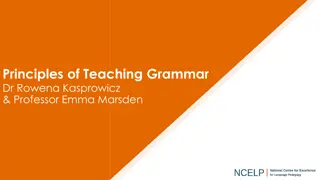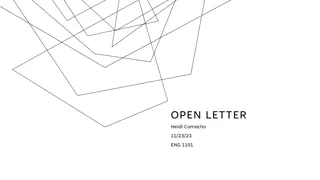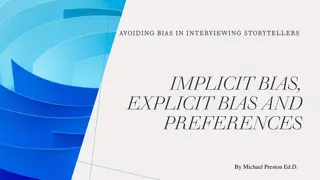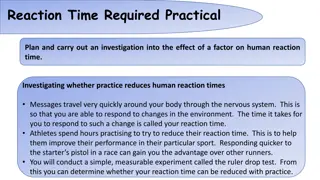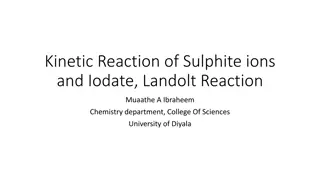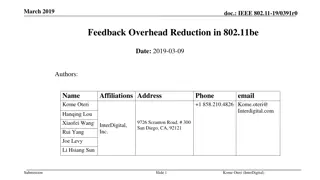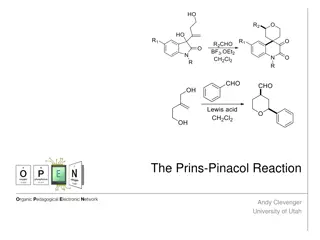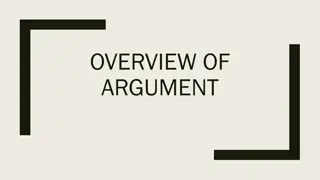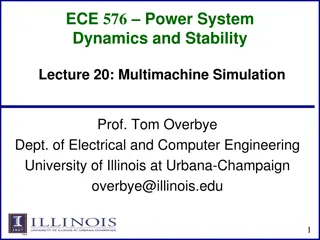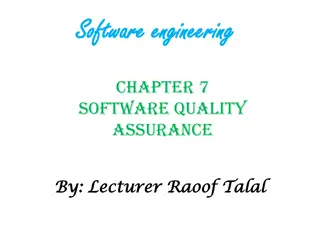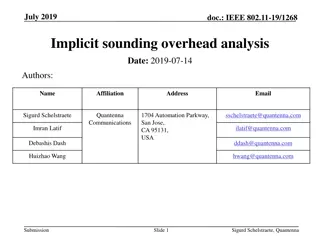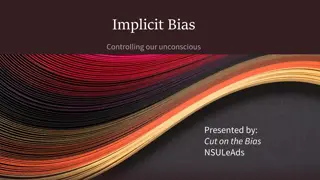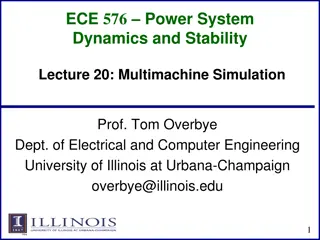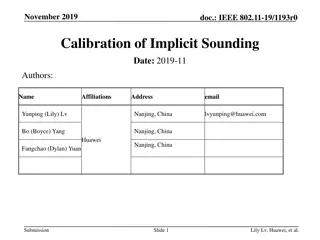Implicit vs. Explicit Processing in L2 Learning and Reaction Times
In second language research, the focus on implicit versus explicit processing is crucial for theory and pedagogy. Research by Batterink et al. (2014) explored L2 learning without awareness, revealing varied effects on reaction times and ERP responses based on participants' awareness of hidden grammar rules. The question remains: Do reaction times in rule-aware participants reflect implicit or explicit processing?
Download Presentation

Please find below an Image/Link to download the presentation.
The content on the website is provided AS IS for your information and personal use only. It may not be sold, licensed, or shared on other websites without obtaining consent from the author.If you encounter any issues during the download, it is possible that the publisher has removed the file from their server.
You are allowed to download the files provided on this website for personal or commercial use, subject to the condition that they are used lawfully. All files are the property of their respective owners.
The content on the website is provided AS IS for your information and personal use only. It may not be sold, licensed, or shared on other websites without obtaining consent from the author.
E N D
Presentation Transcript
Are ERP indices of explicit L2 processing related to reaction times? David Abugaber University of Illinois at Chicago 3rdChicago Sentence Processing Meeting 6/21/2019 david.abugaber@gmail.com www.davidabugaber.com
A major topic in second language research is the implicit vs. explicit nature of processing This question is relevant for second language theory and pedagogy! Grammar drills -> explicit Naturalistic language exposure -> implicit
L2 learning without awareness: Batterink et al. (2014) design 1 out of every 7 trials violated the hidden grammar rule Behavioral and ERP effects to rule-violating trials would indicate learning Post-experiment questionnaire to determine if participants became aware of the hidden grammar rule
L2 learning without awareness: Batterink et al. (2014) results Half of participants became aware of the grammar rule They showed... Reaction time effect P600 ERP response Half of participants did not become aware of the grammar rule They showed... Reaction time effect Early negativity ERP response
But what do reaction times in rule-aware participants actually reflect? Implicit processing or explicit processing? Possibility #1: Rule-aware participants are processing entirely explicitly Explicit processing associated with reaction times Possibility #2: Rule-aware participants are processing implicitly AND explicitly at the same time EEGs doesn t help here: positive P600 cancels out an early negativity in the univariate EEG signal Implicit processing associated with reaction times Look at relationship between P600 and reaction times to distinguish these possibilities: If P600 is time-locked to reaction times... ... then explicit processing is associated with the response If P600 effect has no temporal relationship with reaction times... ... then explicit processing is functionally unrelated to the response
Response time-sorted ERP images Shown for Pz electrode (locus of explicit P600 effect)
Reaction-timed binned analysis Step 1: divide each participant s trials into quartiles by reaction time 4 categories: trials with fastest, middle-fastest, middle-slowest, and slowest response times Step 2: calculate the average P600 latency in each bin Step 3: one-way ANOVA Dependent variable: P600 latency Independent variable: reaction time quartile (fastest, middle-fastest, etc.) RESULTS F(3, 56) = 2,187.0, p < .001, p2 = .994 In other words, the fastest-RT bin has faster P600s, the second-fastest RT bins has slightly slower P600s, etc.
Conclusion Eyeballed ERPimages + response-time binning analysis indicate relationship between reaction time and P600 component Suggests that, for rule-aware participants, conscious processing is driving reaction times in the linguistic task But! More analyses to perform to establish reaction-time alignment: Calculate correlations between response times and individual trial component latencies (Kutas et al., 1977; Sassenhagen et al., 2014) Inter-trial phase coherence to stimulus onset vs. to participant response time (Delorme, Westerfield, & Makeig, 2007) Also, use multivariate analyses of EEG data to look for signs of implicit processing in rule-aware participants (feel free to ask me about this later!)
References Batterink, L. J., Oudiette, D., Reber, P. J., & Paller, K. A. (2014). Sleep facilitates learning a new linguistic rule. Neuropsychologia, 65, 169-179. Jung, T. P., Makeig, S., Westerfield, M., Townsend, J., Courchesne, E., & Sejnowski, T. J. (2001). Analysis and visualization of single-trial event-related potentials. Human Brain Mapping, 14(3), 166-185. Kiesel, A., Miller, J., Jolic ur, P., & Brisson, B. (2008). Measurement of ERP latency differences: A comparison of single participant and jackknife based scoring methods. Psychophysiology, 45(2), 250-274. Kutas, M., McCarthy, G., Donchin, E. (1977). Augmenting mental chronometry: The P300 as a measure of stimulus evaluation time. Science, 197(4305), 792-795. Marathe, A., Ries, A.J., & McDowell, K. (2013). A novel method for single-trial classification in the face of temporal variability. In D.D. Schmorrow, C.M. Fidopiastis (Eds.), Augmented Cognition (pp. 345-352). Heidelberg: Springer. Poli, R., Cinel, C., Citi, L., & Sepulveda, F. (2010). Reaction-time binning: A simple method for increasing the resolving power of ERP averages. Psychophysiology, 47(3), 467-485 Roth, W. T., Ford, J. M., & Kopell, B. S. (1978). Long latency evoked potentials and reaction time. Psychophysiology, 15(1), 17-23. Sassenhagen, J., Schlesewsky, M., & Bornkessel-Schlesewsky, I. (2014). The P600-as-P3 hypothesis revisited: Single-trial analyses reveal that the late EEG positivity following linguistically deviant material is reaction time aligned. Brain and Language, 137, 29-39.
Sample stimuli Animate: aardvark, albatross, alligator, alpaca, amoeba, amphibian, anaconda, angelfish, ant, anteater, antelope, ape, armadillo, baboon, badger, barnacle, barracuda, beagle, bear, beaver, bedbug, bee, beetle, beluga Inanimate: airplane, album, ambulance, anchor, appliance, apron, armoire, arrow, axe, backpack, ball, balloon, bandage, barrel, basket, bathtub, battery, bed, belt, bench, bicycle, binder, blanket, blender, blinds Other confounds? Arousal, emotional valence, concreteness, manipulability, priming across items due to coherence within category Stimuli in Batterink et al. (2014) are oriented to ANIMALS, not just animate in general
Early studies on L2 rule awareness Green & Hecht (1992): Participants performance in grammar sentence corrections tasks do not correspond to their verbalized metalinguistic knowledge BUT limitations from open-ended nature of verbalization task, wide range of grammatical rules involved Leow (2000): In an offline crossword task experiment with Spanish conjugations, only participants whose think-aloud verbal reports indicated rule-awareness showed significant gains BUT possible reactivity effects from simultaneous think-aloud task (e.g., Sachs & Polio, 2007)
SLA research on implicit/explicit interface Cintr n-Valent n & Ellis (2015) Eye-tracking study with English-L1 and Chinese-L1 participants reading Latin Metalinguistic instruction (explicit) could induce participants to use morphosyntactic cues in real time (implicit) Supports the weak and strong interface hypotheses Andringa & Curcic (2015) Eye-tracking study using visual world paradigm; Dutch-L1 learners of an artificial language Metalinguistic instruction (explicit) did not lead to differences in eye movement behavior indicative of real-time prediction (implicit) Supports the no-interface hypothesis Suzuki & DeKeyser (2017) For cohort of advanced L2 learners of Japanese, collected various online (implicit) and offline (explicit) measures of L2 knowledge; non-linguistic measures of implicit and explicit learning aptitude Structural equation modeling showed that explicit learning aptitude significantly predicted acquisition of explicit knowledge, which in turn significantly predicted acquisition of implicit knowledge Supports the weak and strong interface hypotheses
EEG recording and pre-processing Continuous recording in DC mode with sampling rate of 512 Hz from 32 Ag/AgCl electrodes embedded in ANT Neuro-brand Waveguard distributed in standard and extended 10-20 locations (Jasper, 1958: FP1, FPz, FP2, F7, F3, Fz, F4, F8, FC5, FC1, FC2, FC6, T7, C3, Cz, C4, T8, CP5, CP1, CP2, CP6, P7, P3, Pz, P4, P8, POz, O1, Oz, O2), as well as from electrodes placed on the left (M1) and right (M2) mastoids. All electrode impedances below 5 k . Scalp electrodes will be referenced online to the common average of all electrodes. Vertical electrooculogram (VEOG) and horizontal electrooculogram (HEOG) to detect eye movement artifacts EEG signal amplified at 22 bits using an ANT Neuro bioamplifier system (AMP-TRF40AB Refa-8 amplifier), digitized with a 512 Hz sampling rate, and filtered with a digital finite impulse response low-pass filter with a 138.24 Hz cutoff (sampling rate * .27), as implemented by ANT Neuro s asa recording software. All offline data processing carried out using the EEGLab (Delorme & Makeig, 2004) and ERPLab (Lopez-Calderon & Luck, 2014) MATLAB toolboxes For univariate ERP analyses only, IIR-Butterworth band-pass filter (DC set to high-pass 0.1Hz, low-pass 30.0Hz based on a 200ms moving window with a 50ms moving step, with 12dB/octave and 40dB/decade attenuation). For all proposed EEG analyses, any artifacts >50 V in either EOG or EEG will be detected and excluded using EEGLab s automatic artifact-detection feature. Independent Component Analysis correction (EEGLAB; Delorme & Makeig, 2004) performed as per standard analysis procedures (Batterink & Neville, 2011). Data will be re-referenced offline to mean of the mastoid electrodes (M1 and M2). Epochs extracted from -200 to 1200ms relative to onset of noun, or to -200 to 1000ms relative to onset of artificial language article Visually inspected for anomalies/artifacts in remaining EEG data. These preprocessing steps align with those in Batterink et al. (2014). elastic cap 24
Analysis details Response-time binning (Poli et al., 2010; Marathe et al., 2013): compare P600 latencies in each participant s trials quartiled by response times Following standard procedures (Kiesel, Miller, Jolicoeur, & Brisson, 2008; Luck, 2014; Ulrich & Miller, 2001): exclude outlier trials with the 5% lowest and 5% highest reaction times (calculated per participant) set all negative values to zero to avoid contributions from a negative component construct jackknife averages to increase the stability of our findings estimate P600 component onset by using 33% fractional latency of the area under the positive curve. Repeated-measures one-way ANOVAs on P600 latencies with factor of reaction time quartile
Fastest trials ERP latency Faster trials ERP latency Slower trials ERP latency Slowest trials ERP latency Raw numbers Participant 1 24 27 22 27 26 25 27 25 24 26 43 33 27 26 29 46 49 48 50 49 51 54 48 55 50 50 55 48 55 49 89 84 90 90 84 84 86 91 83 84 83 89 82 90 83 123 121 122 122 121 123 121 126 122 121 121 122 119 123 121 Participant 2 Participant 3 F(3, 56) = 2,187.0, p < .001, p2 = .994
Response time-sorted ERP images Shown for P4 electrode (locus of implicit negativity effect)
